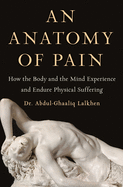
Trained as an anesthesiologist, Abdul-Ghaaliq Lalkhen, now a member of the Faculty of Main Medicine at the Royal College of Anesthetists in London, is an expert in pain. With An Anatomy of Pain, he thoughtfully illuminates how little is known about how it is experienced, understood and treated in modern medicine. Lalkhen focuses on how the misunderstandings of pain's inner workings, by both medical professionals and people experiencing it, have shaped various treatments of it, including patterns in prescriptions and accidental solutions that might cause relief, but are not always a cure.
Lalkhen overall seeks to reform readers' understanding of pain. It is not always due to singular or acute experiences, but rather "a warning system" for the body that people can learn and relearn to respond to. It is, moreover, "a complex experience and not one over which we have mastery, neither when it has been triggered due to injury nor when it has become chronic pain." His text takes readers through histories of the conceptualization of pain in different cultures, various categorizations of pain and approaches to their treatments, and treatments including opiates, injected treatments and spinal cord stimulators. Overall, Lalkhen advocates for a multipronged approach that relies less on direct, singular interventions, and more on approaches that combine physiotherapeutical, medical and psychological treatments. As he writes, pain is, after all, "both a sensory and an emotional experience.... It is only by addressing the complete experience of pain that we can hope to manage pain and alleviate suffering." --Michelle Anya Anjirbag, freelance reviewer

